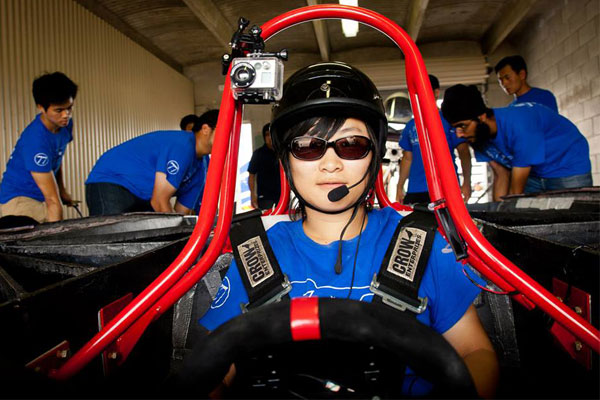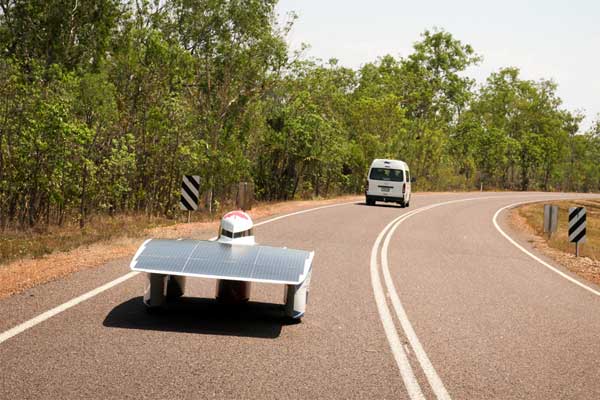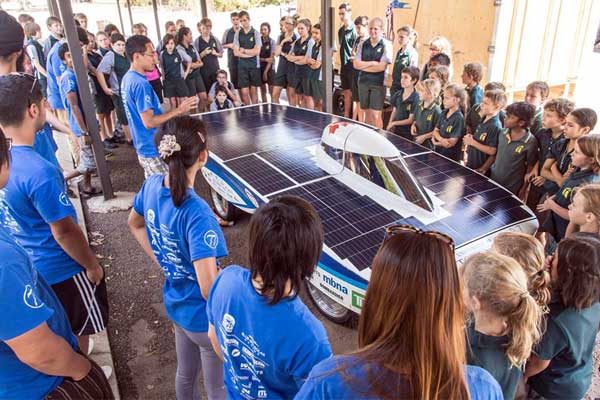
Oct. 3, 2013
By Terry Lavender
While their fellow U of T students are studying for midterms and wondering whether to get their heavier coats out of the closet, 15,500 kilometres and 14 time zones away, the members of the U of T Blue Sky Solar Racing team is sweltering in 40-degree heat and feverishly preparing their B-7 solar-powered car for a gruelling 3,000-kilometre race across Australia.
The Blue Sky team, composed mostly of U of T engineering students, has been preparing for the annual Bridgestone World Solar Challenge for the past two years. When the race begins on Oct. 6, they’ll be competing against 39 other teams from 23 countries, including teams from Cambridge, Stanford and the University of Michigan, the defending champions. But the members of Blue Sky are confident they’ll do well in the race.
More important, they’re glad of the opportunity to participate in a global community that promotes solar energy and the continued advancement and application of renewable energy technologies, says the team’s advancement director, Tiffany Hu (Mech 1T4 + PEY).

Since arriving in Darwin a few weeks ago, the team has been testing the car, getting used to the Australian climate and meeting members of the competing teams.
“To be honest, we are pleasantly surprised that B-7 has been showing excellent reliability and stability after almost two weeks of testing in Australia,” Hu says. “Besides occasional scraping of the driver fairing, everything is working fine! We also had a couple small panics where we thought the brake pedal was stuck or when we thought the car wouldn’t start, but they were all quickly realized as small glitches in vehicle operations.”
“Each team is assigned a pit where we can work on the car. When taking a break from our work, we get a chance to visit other teams and look at other solar cars. It’s always a lot of fun meeting people from around the world who have been sharing similar experiences as us: spending ridiculous amount of time to build a solar car. From lending equipment to sharing anecdotes from fabrication, the sense of camaraderie at the track in itself is a unique part of the World Solar Challenge experience.”
Blue Sky has a long history at U of T. The club was founded in 1996 when a small group of Mechanical and Electrical & Computer engineering students came together to form the Advanced Solar Electrical Vehicle Program. Over the years, team alumni have mentored new team members, sharing their expertise and experience. The latest vehicle, B7, features new photovoltaic technologies and aerodynamic design and is 20 per cent lighter than its predecessors.

Hu says all is going well so far. Besides getting ready for the race, they visited Darwin’s Marrara Christian School, where they showed off the car to the students and answered questions.
“While younger students were fascinated by the sound of B-7′s electric horn, older students delved in the principals behind our mechanical and electrical systems,” she says.
For information on the race, visit the official World Solar Challenge website.
Contact:
Marit Mitchell
Senior Communications Officer
The Edward S. Rogers Sr. Department of Electrical & Computer Engineering
416-978-7997; marit.mitchell@utoronto.ca